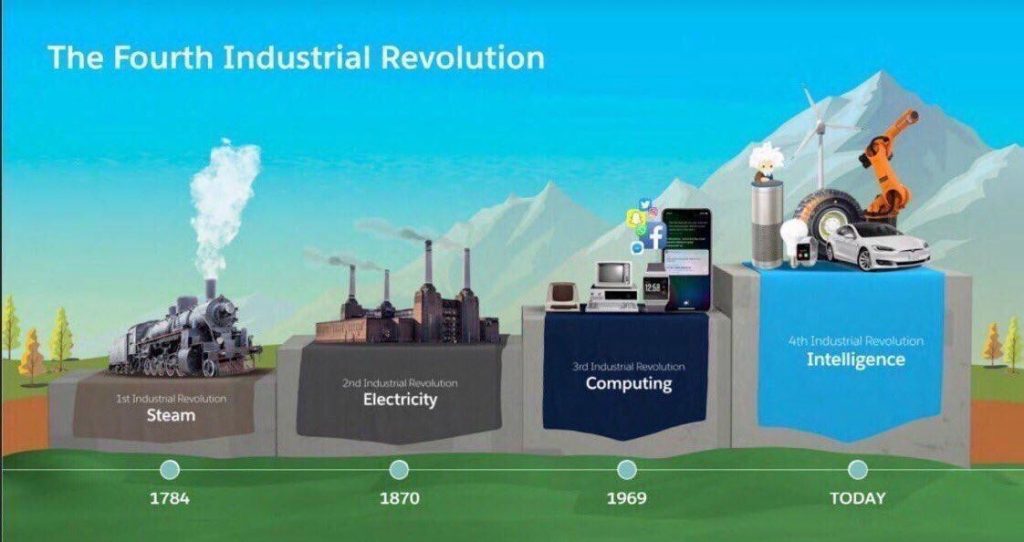4/25/2018
The Fourth Industrial Revolution is a mental model created by the leaders of the Joint Economic Forum and describes how physical, digital and biologic technologies have collided and the resulting challenges and opportunities that presents.
Here is how AI is changing sick care. Here is how 3-D printing is changing sick care. Here are the opportunities using VR/AR in sick care.
Google and Apple will give you the weapons to win.
When software, hardware, materials,biologic systems, cloud, AI/ML and other slicktech collides, it creates an interesting situation with certain highlights. Here are some challenges.
When the agrarian economy evolved into the industrial one, there were three phases that enabled humans to leverage their labor and productivity- those powered by water, electricity and computers/IT technologies. We are now living in the fourth revolution.

Physician entrepreneurs, along with everyone else in the world, will have to change how they adapt if they are to surthrive.
Klaus Schwab has defined four principles which should guide our policy and practice as we progress further into this revolution.
Firstly, we must focus on systems rather than technologies, because the important considerations will be on the wide-reaching changes to business, society and politics rather than technologies for their own sake. The launch of 5G wireless is an example.
Example: Sick care cannot be fixed from inside and will depend on the coherence of diverse ecosystems. While STEM has been the buzzword, BMETAL-the convergence of Business, Medicine, Engineering, Technology, Arts and the Law- will be new paradigm for innovation education and training.
Secondly, we must empower our societies to master technologies and act to counter a fatalistic and deterministic view of progress. Otherwise, there is no room for optimism and positive transformation, and society’s agency is nullified.
Example: We must change how we educate and train the future workforce. In medicine, that will require a re-engineering of workflow, competencies, structure and processes of delivering care as we evolve from a sick care system to a health care system. In addition, we need to address the socioeconomic divides that are contributing to the “deaths of despair”, particularly in white males without a college degree. That will mean rethinking non-college career tracks and retraining programs that are not working.
Here are five of the most in-demand sick care jobs:
1. Data
2. Experience
3. Innovation
4. Blockchain
5. Toucher
Thirdly, we need to prioritize futures by design rather than default. Collaboration between all stakeholders must play a central role in how we integrate these transformative technologies. Otherwise, our future will be delivered by default. Winning the fourth industrial revolution is a wicked problem.
Example: Design thinking needs to place the patient and doctors first. We need to rethink how we educate and train students from P-20.
And lastly, we must focus on key values as a feature of new technologies, rather than as a bug. Technologies used in a way that increase disparity, poverty, discrimination and environmental damage work against the future we seek. For the investment in these technologies to be justifiable, they must bring us a better world, not one of increased insecurity, dislocation and exclusion.
Example: The Fourth Industrial Revolution, like the 3 that preceded it, has already produced inequalities in value and wealth distribution that will exacerbate an already contentious global society.
We also need to be wary of the dark side of AI and answer How can we forecast, prevent, and (when necessary) mitigate the harmful effects of malicious uses of AI?
1. Policymakers should collaborate with researchers to prevent and mitigate malicious uses of AI.
2. Researchers and engineers should consider misuse and reach out to necessary parties when harmful applications are foreseeable.
3. Best practices should be developed for addressing dual-use concerns.
4. Developers should expand the range of stakeholders and experts in discussing these concerns.
Ultimately, winning the fourth sickcare industrial revolution will mean 1) reengineering the processes of care, 2) delivering user defined value, and 3) doctors and patients saying “no” to unnecessary and wasteful spending as the price for access and quality. Here are some other tactics:
One key to winning the fourth industrial revolution is to speed the pace of digitization and robotics in sick care, not slow it, and do to sick care what it has done to financial services and retail.
Change is happening faster and it outpacing the ability of many to cope with it. Unless we take control and prepare people, including physician entrepreneurs and their patients for the future, the cracks in our society will widen.